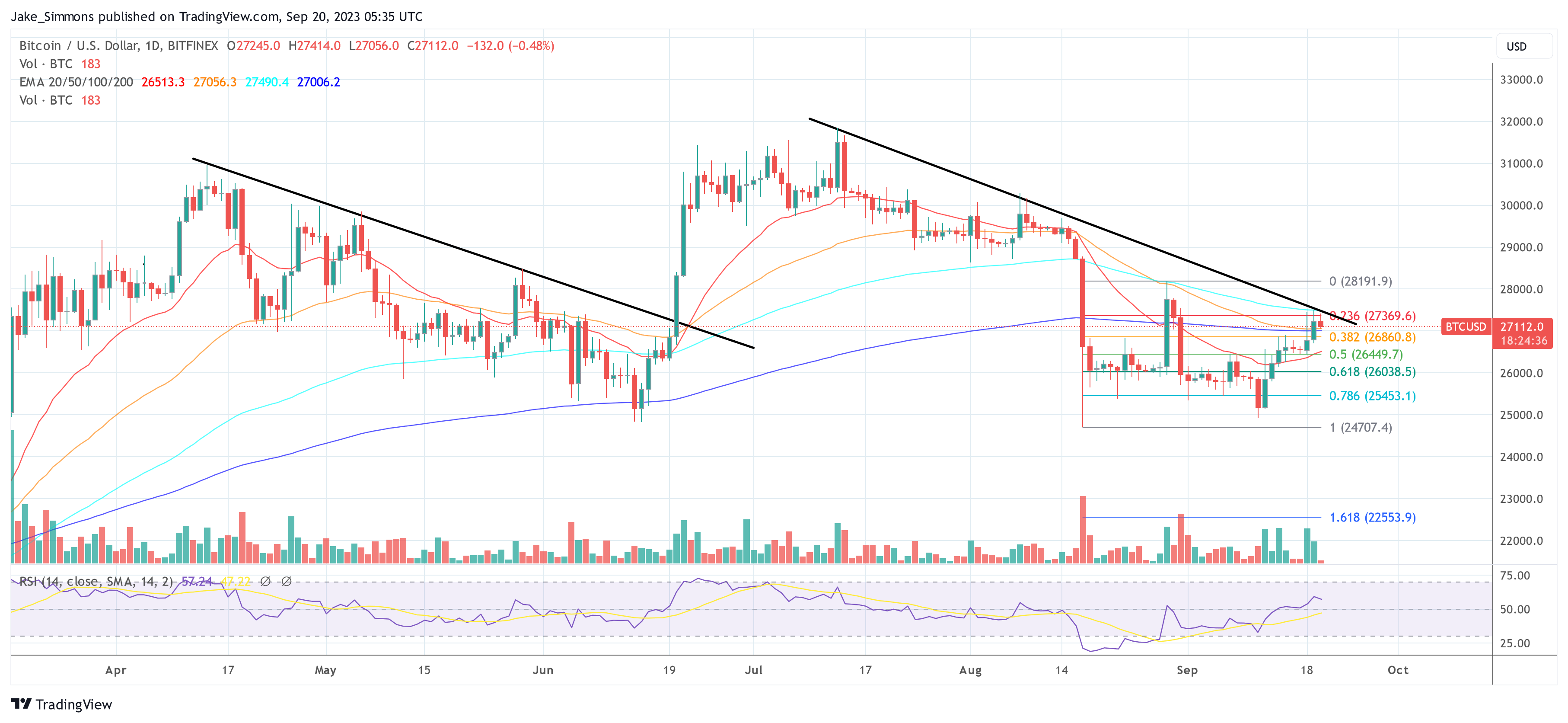In a meticulous and comprehensive analysis shared on X, prominent analyst Will Clemente delved deeply into Bitcoin’s current stance against the prevailing macroeconomic landscape, connecting broad fiscal trends with the future trajectory of the digital asset.
Bitcoin’s Genesis And Modern Economic Constructs
Clemente initiates his exposition with a reference to Bitcoin’s present situation, where despite facing a decline of nearly 70% from its 2021 highs, its potential remains undiminished. He reminded readers of Bitcoin’s inception, born out of the tumultuous aftermath of the 2008 financial crisis. Satoshi Nakamoto, Bitcoin’s elusive creator, envisioned it as an antidote to the “moral hazard and incentives set in place” that could disrupt the very “fabric of financial perception.”
Supporting his argument, Clemente threw a spotlight on the alarming debt growth: over the last 15 years, the “federal debt as a percentage of GDP (The US economy’s output) has ascended from 60% to a staggering 120% today.” This surge in debt stands in sharp contrast to the actual growth of the US economy.
He elaborated, “Even though the economy’s growth exceeded expectations, registering 2.4% (annualized) in the recent second quarter, public debt overshadowed it by swelling 2.7%, which annualizes to an unsettling 10.8%.”
This disparity, Clemente warns, places the U.S. in a challenging position. Bridging this gap mandates either a herculean economic growth driven by groundbreaking innovations or a stringent curb on debt, which seems politically implausible given the “incentives to be liked and re-elected.”
The Looming Debt Issue
Broadening his analysis, Clemente addresses the demographic shifts, particularly the financial implications of the aging baby boomer generation. The burden of their social security programs falls on a younger, financially strained working class, intensifying the fiscal strain.
So, given this increasing debt, how does the U.S. intend to address it? Clemente suggests that the solution might lie in monetary debasement, an economic maneuver where the value of currency is deliberately reduced. He elucidated this concept: “By inflating the monetary base (by, for instance, printing more money), debt can be paid back in nominal terms, but its real value (adjusted for inflation or debasement) gets effectively reduced.”
Navigating Assets in a Debasing Economy
Turning his lens to assets in such an environment, Clemente posed the vital question: Which assets are poised to thrive in a constantly debasing economy? He scrutinized a variety of options from stocks, which have shown consistent growth, to real estate, commodities, and venture capital.
Equities have been dependable for many, but Clemente pointedly remarks that when adjusted for the M2 money supply growth, the returns of indices like the S&P 500 are not as remarkable. “Interestingly, relative to M2 money supply, the S&P 500 has barely made new highs. This hints at stocks being susceptible to the very debasement that affects fiat currencies”, Clemente noted.
Real estate, while a tangible hedge against inflation, suffers from illiquidity. On the other hand, venture and angel investing, though potentially lucrative, have barriers that might keep average citizens at bay.
Commodities like gold have been age-old shields during financial unrest. However, in Clemente’s view, Bitcoin emerges as a formidable contender in this space. Post its next halving, Bitcoin’s stock-to-flow ratio—a measure of scarcity—will outstrip both gold and silver. Beyond metrics, Bitcoin’s inherent properties, such as portability and verifiability, cement its position as a unique financial instrument.
While recent monetary policies like rate hikes have impacted Bitcoin’s short-term value, Clemente stresses that the long-term scenario shaped by unchecked fiscal policies remains. In this landscape, Bitcoin, with its algorithmically limited supply, could offer a resilient hedge against central bank-induced debasement.
Global Sentiments & Bitcoin’s Ascendance
Broadening his vista, Clemente references a United Nations report to elucidate the global sentiment. A noticeable rise in negative news, coupled with declining global living standards, sets the stage. This pessimism, combined with a heightened political polarization globally, paints a grim picture.
Delving into the root causes, Clemente identifies monetary debasement as a probable driving factor. He explained, “The continuous expansion of the money supply enriches asset holders, yet makes asset acquisition increasingly insurmountable for those without them.” This widening chasm, he proposes, is propelling a societal shift towards disillusionment with the traditional system.
Concluding his exhaustive analysis, Clemente accentuates that these intertwined economic, sociopolitical, and demographic factors collectively create a fertile ground for the ascendancy of Bitcoin. Its digital nature, combined with the inherent scarcity and decentralized ethos, positions it as a viable alternative in an increasingly unstable financial landscape.
In his own words, when forecasting the cryptocurrency’s potential over an extended period, Clemente succinctly stated, “All to say, over a decade plus time horizon, orange coin good.”
At press time, BTC traded at $27,112.

Source: https://bitcoinist.com/bitcoin-best-bet-macro-landscape/
